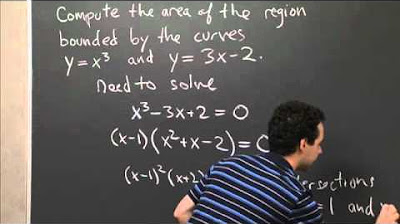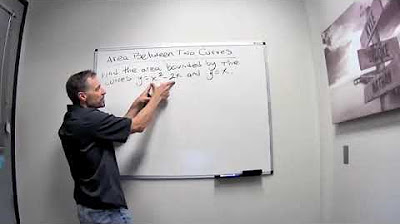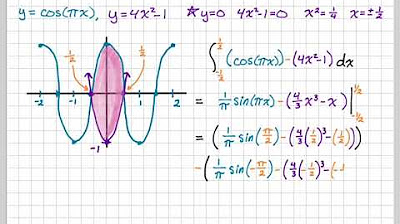Horizontal area between curves | Applications of definite integrals | AP Calculus AB | Khan Academy
TLDRThe video script presents a mathematical problem involving the intersection of two curves, where x is a function of y. The focus is on calculating the area between the curves by setting up a definite integral with respect to y, using the points of intersection as bounds. The solution involves finding the intersection points by equating the expressions of the two curves, simplifying the resulting quadratic equation, and then evaluating the antiderivative of the difference between the functions over the interval defined by the y-coordinates of the intersection points. The final answer is computed with careful attention to detail, resulting in a numerical value for the area.
Takeaways
- 📈 The script discusses the process of finding the area between two curves where x is a function of y, not the traditional y as a function of x.
- 🤔 The video encourages viewers to pause and attempt to solve the problem of finding the area between the curves themselves before revealing the method.
- 🧩 The solution involves setting up a definite integral with respect to y, using the y-coordinates of the intersection points as the bounds of integration.
- 📊 The lower bound of integration is denoted as y=1 and the upper bound as y=3, based on the intersection points of the two curves.
- 🔍 Identifying the points of intersection is crucial, which is achieved by setting the two y-dependent x expressions equal to each other and simplifying the resulting quadratic equation.
- 👌 The quadratic equation simplifies to -2y^2 + 2y + 12 = 0, which can be factored into -2(y-3)(y+2) = 0, giving the intersection points y=3 and y=-2.
- 📝 The integral to be evaluated is from y=-2 to y=3 of (-y^2 + 3y + 11) - (y^2 + y - 1) dy, which simplifies to the integral of -2y^2 + 2y + 12 dy.
- 🧮 The antiderivatives are calculated, resulting in -2y^3/3 + y^2 + 12y, which is evaluated at the bounds of the integral.
- 🔢 The final calculation involves evaluating the antiderivative at the upper bound (y=3) and subtracting the evaluation at the lower bound (y=-2) to find the area.
- 🎯 The area between the curves is found to be 47 - 5(1/3), which simplifies to 41 2/3 square units.
Q & A
What is the main topic of the video?
-The main topic of the video is finding the area between two curves where x is a function of y, using definite integration with respect to y.
How does the instructor suggest finding the area between the curves?
-The instructor suggests finding the area by integrating with respect to y, using a definite integral where the bounds are in terms of y, from the lower to the upper point of intersection.
What are the two functions given in the example?
-The two functions given in the example are f(y) = -y^2 + 3y + 11 and g(y) = y^2 + y - 1.
How does the instructor describe the process of setting up the integral?
-The instructor describes the process of setting up the integral by identifying the y-coordinates of the points of intersection as the bounds for the integral and then integrating the difference of the functions, (f(y) - g(y)), with respect to y.
What is the equation used to find the points of intersection?
-The equation used to find the points of intersection is -y^2 + 3y + 11 = y^2 + y - 1. By setting the two expressions equal to each other and simplifying, the points of intersection are found.
How does the instructor simplify the equation to find the points of intersection?
-The instructor simplifies the equation by subtracting y^2, y, and -1 from both sides, resulting in a quadratic equation -2y^2 + 2y + 12 = 0. This is then factored into -2(y - 3)(y + 2) = 0, giving the points of intersection at y = 3 and y = -2.
What is the definite integral set up to evaluate?
-The definite integral set up to evaluate is from y = -2 to y = 3 of (-y^2 + 3y + 11) - (y^2 + y - 1) dy, which simplifies to the integral of (-2y^2 + 2y + 12) dy.
How does the instructor find the antiderivative of the integrand?
-The instructor finds the antiderivative by applying the reverse power rule for integration. The antiderivative is -2y^3/3 + y^2 + 12y.
What are the steps to evaluate the definite integral?
-The steps to evaluate the definite integral are to find the antiderivative, evaluate it at the upper bound (y = 3), and then subtract the value of the antiderivative at the lower bound (y = -2).
What is the final result of the area between the curves?
-The final result of the area between the curves is 41 2/3 square units.
How does the video script illustrate the concept of integration?
-The video script illustrates the concept of integration by using the example of finding the area between two curves. It explains the process of setting up the integral, finding the points of intersection, simplifying the integrand, finding the antiderivative, and evaluating the definite integral to find the area.
What is the significance of the points of intersection in this context?
-The points of intersection are significant because they provide the bounds for the definite integral that is used to calculate the area between the curves. Without these points, the limits of integration would not be known.
Outlines
📚 Introduction to Integrating with Respect to y
The first paragraph introduces the concept of integrating with respect to y, highlighting the unusual setup where x is a function of y. The instructor presents two curves and explains the goal of finding the area between them. A key hint is provided, suggesting the use of a definite integral with bounds in terms of y. The lower and upper bounds of integration are identified as y1 and y2, corresponding to the y-coordinates of the points of intersection of the two curves. The concept of integrating as the sum of infinitely thin rectangles is introduced, with dy representing the height and the difference in x-values (f(y) - g(y)) representing the width.
🧮 Solving the Intersection Points and Evaluating the Integral
In the second paragraph, the process of finding the points of intersection is detailed, which is essential for setting up the integral. The instructor sets the two y expressions equal to each other to find the intersection points by solving a quadratic equation. After simplifying and factoring the equation, the intersection points are determined to be y = -2 and y = 3. The integral is then evaluated from y = -2 to y = 3, with the antiderivative of the integrand being calculated. The final steps involve evaluating the antiderivative at the bounds and computing the difference to find the area, resulting in a final answer of 41 2/3.
Mindmap
Keywords
💡Curves
💡Functions
💡Integration
💡Definite Integral
💡Bounds
💡Infinitely Thin Rectangles
💡Antiderivative
💡Points of Intersection
💡Quadratic Equation
💡Factoring
💡Area Calculation
Highlights
The video discusses the concept of finding the area between two curves where x is a function of y, which is a different perspective from the usual y as a function of x.
The method of integration with respect to y is introduced as a way to calculate the area between the two curves.
The importance of identifying the points of intersection of the curves is emphasized to establish the bounds for the integral.
The process of setting up the integral involves taking the difference of the functions f(y) and g(y) over the interval defined by the y-coordinates of the intersection points.
The video demonstrates the algebraic manipulation of the given functions to find the points of intersection by setting them equal to each other and simplifying the resulting quadratic equation.
The solution of the quadratic equation is obtained through factoring, revealing the intersection points at y = -2 and y = 3.
The definite integral is set up from y = -2 to y = 3, incorporating the expressions for f(y) and g(y).
The calculation involves taking the antiderivative of the integrand and evaluating it at the bounds of the integral.
The process of evaluating the antiderivative at the upper bound (y = 3) and the lower bound (y = -2) is detailed, highlighting the steps of the calculation.
The final result of the area calculation is presented as 27, obtained by summing the results of the upper and lower bounds' evaluations.
The video provides a comprehensive walkthrough of the problem, including the mathematical reasoning and the steps to solve for the area between two curves.
The method showcased in the video can be applied to various problems involving the calculation of areas in the context of functions and integration.
The video emphasizes the practical application of integration in finding areas between curves, which is a fundamental concept in calculus.
The detailed explanation of the steps, from setting up the integral to evaluating it, makes the video a valuable resource for learning and understanding the process.
The video demonstrates the use of the reverse power rule and factoring in solving the integral, showcasing important techniques in algebra and calculus.
The final answer of 41 2/3 is derived after a thorough and methodical calculation, illustrating the precision required in mathematical problem-solving.
Transcripts
Browse More Related Video

Area Between Curves: Integrating with Respect to y (Example 2)

Area Between y=x^3 and y=3x-2 | MIT 18.01SC Single Variable Calculus, Fall 2010

Area Between Two Curves

Finding The Area Bounded By Three Curves Using Definite Integrals - Calculus

Finding the Area Between Two Curves by Integration

Area Between Curves: y = cos(pi*x), y = 4x^2 -1
5.0 / 5 (0 votes)
Thanks for rating: